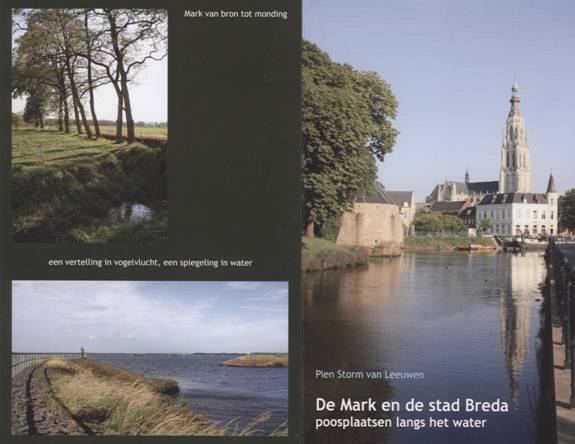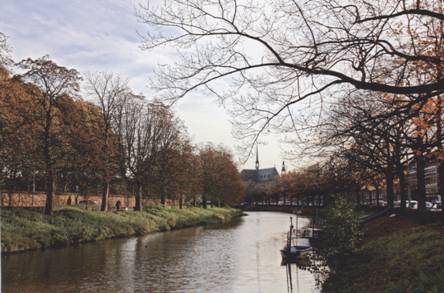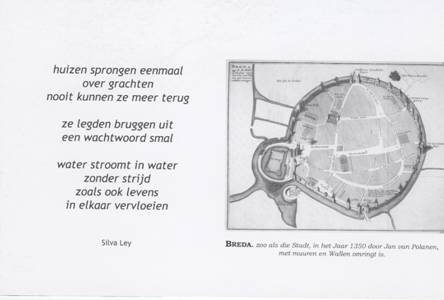|
XXIV:2 |
LYNX
A Journal for Linking Poets |
||||
|
DE MARK EN DE STAD BREDA. by Silva Ley
On most spots, biker and hiker come across a big stone in which a poem is engraved. Nrs 1 to 15: 1 Source of the Mark (in Belgium) Connecting text: Pien Storm van Leeuwen pien@trajart.nl ISBN 978 – 90 – 71947 – 39 – 1 2 De Mark en de stad Breda
once houses skipped over they displayed bridges water streams into water
(text under map) BREDA, as small as the city was in 1350, In the 19th century the earthen defending walls around the city were destroyed. In very ancient times the region was only a vast moor and watery land. The natural free rein and seasonal overflow of the river was later on regulated in the city Singels, but went on following the original head course. Walnut trees and oak trees, willows and poplars embellish these long waterways across the town. Some streets along are closed for cars, but are frequently used by cyclists. Name : Ceedata E-mail: storm@ceedata.nl Cost: $ 20, -- (all included, also sending by post)
HOW POEMS OF CONSCIOUSNESS FAIL TO DEMONSTRATE THE DISJUNCTIVE DRAGONFLY It seems we have now reached the summer season of professors and pseudo-academics, who unable to write poetry, attempting to fill books with complete nonsense about the statue of their scholastic positions. There is a new big one just in time for falling asleep in a hammock.
Among the odd bits of theory and “key concepts of poetics” the idea that “disjunction” is something new and vital to haiku is being put forth by Richard Gilbert in this book. Through many pages, with all the correct footnotes and references, the reader is supposed to be impressed with this idea that what makes haiku great is this aspect of disjunction.
It is true that the phenomenon of disjunction in poetry has been around since the Greeks first fiddled with it, and the Chinese understood and used the concept long before any one else was that interested in poetry. All these poets understood what Gilbert does not. That one of the aspects of poetry is about finding oneness in the world and showing it to others. We all know intimately about disjunctiveness as we go through days of collecting the most astounding events, people, ideas and impressions crowding together in our minds – often with a clamorous effect. That is not poetry. Disjunctiveness is not a poetical device and especially not one used in haiku and other Japanese genres.
What we learn from poets, from any land, is what the Japanese have learned to do so well – linking. There is the poetry. The way words and images are used to carry ideas and images from one mind to another is the skill of writing. The art of poetry comes from the heart and minds of poets and their readers as they form the linkages between a disparity of ideas or objects. How one goes from puppies to stars is much more interesting to the poet than the idea that yes! these seem to be two separate and distinct things. Hello?
The challenge is to find that small pivot, that pinpoint where two images cross, while stretching the mind as far as one can and then to create the words that call up additional images that take the reader by the hand while crossing from one to the other. That is haiku. That is how it works. pine and cypress Professor Gilbert fails to understand this. That is why his listing of the haiku techniques, which I first discovered and he has now renamed and claimed as his own, falls so flat in his book. He is interested in the separateness of things, and these techniques were created to help the haiku writer, or any one else, build the bridges needed between any two or more parts of the poem. He can glibly give the techniques new and meaningless names because he does understand how and why to use them. He is like the cat that looks at the finger pointing to the mouse instead of being the poet who makes the leap to catch the bit of life across the room.
There are a lot of good men in the haiku scene and many of them write excellent haiku. What the world does not need is a bunch of them ganging up, ignoring women, who do more of the writing than they do, and then discussing with pursed lips and pages of gestures how mysterious it is and yet how they know it all – with footnotes. Most of the references to books Gilbert studied are by men and it is the men who will now endlessly discuss the fact that the book is not very good, and probably its only value is in the added on interviews with German and Japanese (mostly) men. So ladies, if you wish to spend $28.00 plus postage to find yourself ignored and blarney-stoned about theories that do not hold water; go get the book on your way to the nunnery.
|
|||||
ARTICLES DE MARK EN DE STAD BREDA. by Silva Ley
HOW POEMS OF CONSCIOUSNESS FAIL TO DEMONSTRATE THE DISJUNCTIVE DRAGONFLY by |
|||||
Back issues of Lynx:
|
Next Lynx is scheduled for October, 2009 .
| ||||


